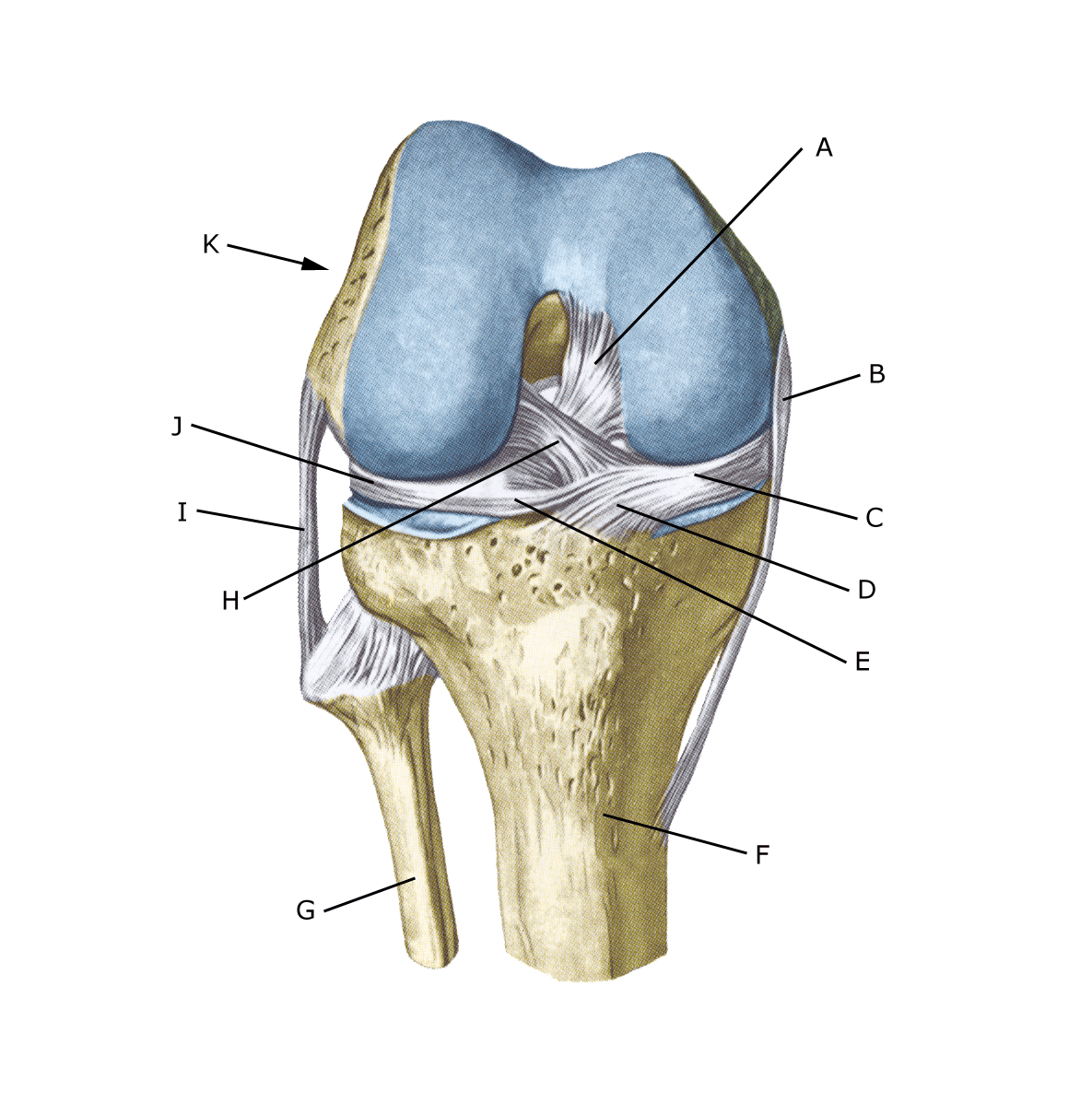Anatomy
The bones of the knee joint include the femur (thigh bone), tibia (shin bone) and patella (kneecap). There is also a small joint between the tibia and fibula (fibula). Inside the knee is an anterior and posterior cruciate ligament. The knee joint is reinforced by a joint capsule that is laterally reinforced with an external and an internal collateral ligament (ligamentum collaterale laterale (LCL) and ligamentum collaterale mediale (MCL), which, among other things, ensures the lateral stability of the knee. The medial collateral ligament (MCL) attaches to the inside of the femur (medial femoral condyle) and tibia (tibia).
 Knee joint from the front
Knee joint from the front
A. Ligamentum cruciatum posterius
B. Ligamentum collaterale mediale/tibiale
C. Meniscus medialis
D. Insertio anterior menisci medialis
E. Ligamentum transversum genus
F. Tibiae
G. Fibulae
H. Ligamentum cruciatum anterius
I. Ligamentum collaterale laterale/fibulare
J. Meniscus lateralis
K. Femur
 Knee from the front
Knee from the front
A. Tendo m. adductoris magni
B. Retinaculum patellae mediale
C. Meniscus medialis
D. Ligamentum collaterale mediale/tibiale
E. Bursa anserina
F. Bursa subtendinea m. sartori
G. Ligamentum patellae
H. Patella
Cause
When the tibia is pressed inwards in relation to the femur (calf knee, valgus), the inner collateral ligament is stretched. If the load is high enough (as is often the case if the load comes unprepared so that the thigh muscles do not have time to tense and stabilise the knee joint), the ligament can rupture. It is most commonly seen in football, basketball and skiing, among others.
Symptoms
Sudden onset of pain on the inside of the knee after twisting the knee. Sometimes a pop is felt when the ligament ruptures. In severe cases, the athlete complains of a feeling of looseness in the knee. In mild cases, the sporting activity can continue for a (short) period of time.
Examination
If total or partial rupture of the knee ligaments is suspected, a clinical examination should be performed by an appropriate medical professional to ensure the correct diagnosis and treatment. There is always tenderness corresponding to the rupture and there is aggravation when the ligament is stability tested on a slightly bent knee (MCL video).
When the knee is stretched, the looseness is cancelled. If the knee is stable, the injury is called a ‘sprain’ of the medial collateral ligament. If the knee is loose, the injury is referred to as a ‘rupture’ of the ligament. If there is any doubt about the diagnosis, an ultrasound scan can be performed where the tear, possible bone tearing at the attachment and bleeding along the ligaments can be seen. See ultrasound scan.
Occasionally, late calcifications are seen at the attachment of the medial collateral ligament (MCL) to the femur (Pellegrini-Stieda lesion). MRI scans are indicated if other injuries are suspected, for example inside the knee.
Treatment
The treatment of total or partial tears of the medial collateral ligament includes offloading and rehabilitation. If the knee is severely loose, a support splint (Don-Joy) can be used for a short period (e.g. 5 weeks). Previous surgical treatment is now largely abandoned for uncomplicated ruptures of the medial collateral ligament (Kim C, et al. 2021). Only in rare cases of severe chronic internal lateral laxity can surgical stabilisation be considered.
The prognosis is good and the vast majority return to sport at the same level after 4-5 months after total ruptures, and after 6 weeks for pre-stretching,
Bandage
A hinge bandage can be used for a short period (e.g. 5 weeks) in the beginning (Don-Joy). Tape treatment of lateral knee ligament ruptures is often used as a supplement to other rehabilitation treatments, although there is little evidence of effectiveness.
Complications
If no progress is made, you need to consider whether the diagnosis is correct. It will often require additional examinations (X-ray, ultrasound scan, MRI scan or arthroscopy).
In particular, the following should be considered:
- Meniscus lesion
- Outer collateral ligament rupture
- Rupture of the posterior cruciate ligament
- Cartilage damage in the joint
- Periosteal tears and fractures.
